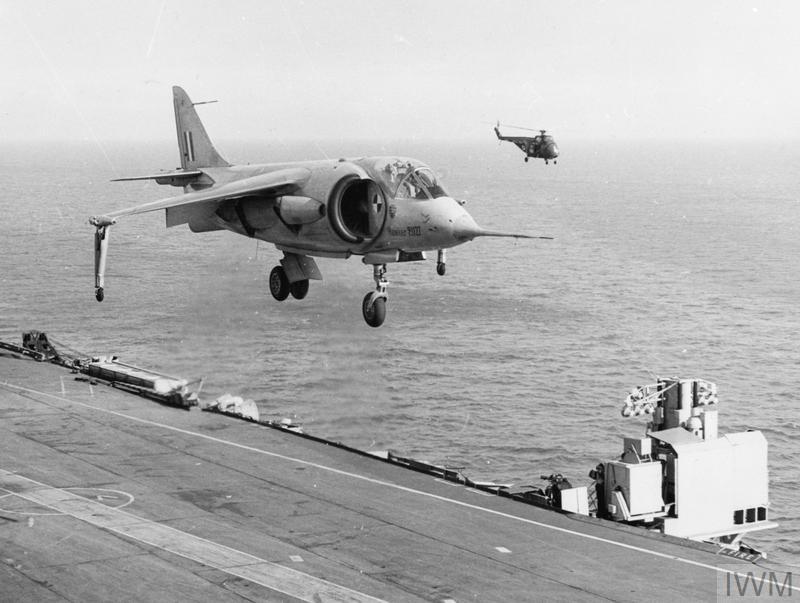Remember the XV-6A?
While the U.S. Marine Corps would not take delivery of their first AV-8A Harriers until January 1971, over a decade had elapsed since the original Hawker P.1127 prototype first hovered in tethered flight (21 October 1960) and much ground had been covered in between.

Hawker P1127 made the first-ever vertical landing by a jet aircraft an a carrier at sea on HMS Ark Royal in February 1963. IWM A 34711
In fact, the U.S. Army, Navy, USAF, and Marines formed a joint evaluation squadron and tested a half-dozen early Harriers at sea and ashore as early as 1966, all with the idea of using the aircraft for close air support.
We are talking about the Hawker Siddeley XV-6A Kestrel.

XV-6A aircraft lifts off flight deck of USS RALEIGH (LPD-1) during evaluation operations at sea, May 1966. USN 1115763

XV-6A aircraft touches down on board the supercarrier USS INDEPENDENCE (CVA-62) during evaluation operations, May 1966. USN 1115758-C
As noted by the NHHC:
The 1957 design for the Hawker P.1127 was based on a French engine concept, adopted and improved upon by the British. The project was funded by the British Bristol Engine Co. and by the U.S. Government through the Mutual Weapons Development Program.
With the basic configuration of the engine largely determined and with development work under way, Hawker Aircraft Ltd. engineers directed their attention to designing a V/STOL aircraft that would use the engine. Without government/military customer support, they produced a single-engine attack-reconnaissance design that was as simple a V/STOL aircraft as could be devised. Other than the engine’s swivelling nozzles, the reaction control system was the only complication in the effort to provide V/STOL capability.
The initial P.1127 was rolled out in the summer of 1960, by which time RAF interest in the aircraft had finally resulted in funding by the British Government for the two prototypes. First hovers in the fall were made with a severely stripped airplane. This was due to the fact that the first Pegasus engines were cleared for flight at just over 11,000 pounds thrust.
With potential NATO and other foreign interest in the P.1127, four additional airplanes were ordered to continue development.
As the project proceeded into the early sixties international interest in V/STOL tactical aircraft led to an agreement to conduct a tripartite operation, with the United Kingdom, West Germany and the United States sharing equally in development and evaluation. Nine P.1127s were ordered and designated Kestrel F.G.A. 1s in the RAF name system. A number of major configuration changes were incorporated in it although the basic concept remained unchanged. Within the United States it was a tri-service venture (Army, Navy, Air Force) with the Army functioning as the lead service. However, the final interservice agreement later transferred responsibility for this category of aircraft to the Air Force.
Following completion of the operational evaluation in the United Kingdom, six of the Kestrels were shipped to the United States in 1966, designated XV-6As. Here they underwent national trials, including shipboard tests. Two subsequently served in a research role with NASA.
In the end, the Army bowed out and kept the OV-1 Mohawk in service for a generation–augmented by the new AH-1 Cobra for close air support. The Air Force walked away and would go on to develop the A-10 Warthog. The Navy let the Marines go ahead– with the prospect of using Harriers in a sea control role if needed.
Four of the six American XV-6As are preserved in the states while a fifth was sent back “home” to be preserved in England.
XS694 (NASA 520) XS689 (NASA 521)

One (262) is preserved at the National Museum of the U.S. Air Force-– complete with USAF markings.




Pingback: Plumbing the Archives (and finding some gems!) | laststandonzombieisland
Pingback: Jump Jets in the Jungle | laststandonzombieisland
I was aboard the USS Raleigh (LPD-1) for a training cruise. while conducting what was referred to as ”Harrier OPS”. Quite an impressive sight, especially some 50 years ago.